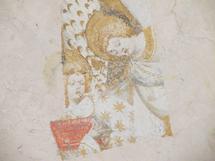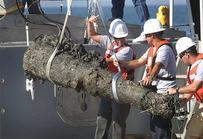27 OCTOBRE
INDI-UNI : ANTHROPOLOGY - ARCHAEOLOGY
INSCRIPTION 2011 – 2012 COURS A DISTANCE
REGISTRATION 2011 – 2012 ONLINE COURSES
CAMBODGE - Angkor Wat - Archaeologists at Cambodia’s famous Angkor Wat temple complex say they have unearthed the largest Buddhist statues there in eight decades. Ly Vanna, an artifacts expert for the government’s Apsara Authority that oversees the site, said Thursday the two stone statues found at Ta Prohm temple were headless but the larger one if complete would stand about 10 feet (3 meters) tall. He says the statues are believed to date from the 12th century and are the biggest discovered since the 1930s.
http://asiancorrespondent.com/68254/archaeologists-discover-rare-statues-at-angkor-wat-2/
PEROU -  Lambayeque - Archaeologists in Lambayeque, Peru, have uncovered a 900-year-old Sican tomb, believed to be the final resting place of an elite figure in society. "We have been digging since last February and in the zone we called the Palace, a chamber had been detected and that led to the discovery of the tomb of someone very important of the Lambayeque elite, approximately from the 12th century. His burial was preceeded by a series of offerings," said a local archaeologist. ITN News reported that the burial chamber is more than nine hundreds years old and it was found in the Chotuna-Chornancap area, known to have ceremonial significance. "On reaching the level of the burial the person's tomb appeared, first with a crown of copper and silver, a copper mask with teeth, a necklace of disks and other ornaments made of copper," the archaeologist added. Those items will help researchers piece together information on burial traditions and they also hope to be able to work out more about the life of the clearly important person.
Lambayeque - Archaeologists in Lambayeque, Peru, have uncovered a 900-year-old Sican tomb, believed to be the final resting place of an elite figure in society. "We have been digging since last February and in the zone we called the Palace, a chamber had been detected and that led to the discovery of the tomb of someone very important of the Lambayeque elite, approximately from the 12th century. His burial was preceeded by a series of offerings," said a local archaeologist. ITN News reported that the burial chamber is more than nine hundreds years old and it was found in the Chotuna-Chornancap area, known to have ceremonial significance. "On reaching the level of the burial the person's tomb appeared, first with a crown of copper and silver, a copper mask with teeth, a necklace of disks and other ornaments made of copper," the archaeologist added. Those items will help researchers piece together information on burial traditions and they also hope to be able to work out more about the life of the clearly important person.
http://www.andina.com.pe/Ingles/Noticia.aspx?id=8zV4pTCsLEo=
FRANCE –  Souvigny - « Un siècle d’archéologie à Souvigny » présente les « trésors » exhumés lors de campagnes de fouilles qui se sont déroulées tout au long des siècles passés et particulièrement au 21ème. La rétrospective des observations et des découvertes archéologiques éclaire une chronologie de l’occupation du site et de ses environs, ainsi que l’évolution de son urbanisme et de son architecture. Ces travaux ont permis de reconstituer l’organisation du bourg monastique et du prieuré. Une place importante est consacrée à l’archéologie funéraire : tombeaux des saints abbés Mayeul et Odilon, du bâtard de Bourbon, ouvrant sur une étude anthropologique. Les anciennes observations des chapelles des Bourbons seront reprises et confrontées à de nouvelles investigations. Parmi celles-ci, les premiers sondages en vue du dégagement de la peinture de la voûte de la Chapelle Vieille des Bourbons - qui viennent d’avoir lieu en janvier 2011 annoncent d’ores et déjà, de l’avis des scientifiques, une découverte majeure.
Souvigny - « Un siècle d’archéologie à Souvigny » présente les « trésors » exhumés lors de campagnes de fouilles qui se sont déroulées tout au long des siècles passés et particulièrement au 21ème. La rétrospective des observations et des découvertes archéologiques éclaire une chronologie de l’occupation du site et de ses environs, ainsi que l’évolution de son urbanisme et de son architecture. Ces travaux ont permis de reconstituer l’organisation du bourg monastique et du prieuré. Une place importante est consacrée à l’archéologie funéraire : tombeaux des saints abbés Mayeul et Odilon, du bâtard de Bourbon, ouvrant sur une étude anthropologique. Les anciennes observations des chapelles des Bourbons seront reprises et confrontées à de nouvelles investigations. Parmi celles-ci, les premiers sondages en vue du dégagement de la peinture de la voûte de la Chapelle Vieille des Bourbons - qui viennent d’avoir lieu en janvier 2011 annoncent d’ores et déjà, de l’avis des scientifiques, une découverte majeure.
http://www.tourmagazine.fr/Allier-Un-siecle-d-archeologie-a-Souvigny_a18960.html
SRI LANKA – Jaffna - Archaeological excavations have commenced in Jaffna. A tablet monument has been found in diggings carried out near the historic Kandurugoda temple in Jaffna recently. The monument has been placed at the Jaffna museum for public inspection. It has been identified that the monument was presented to the temple by King Kashyapa the fourth. Coins belonging to the periods of 11th and 13th centuries were also unearthed in the excavations. Commissioner General of archaeology Dr. Senarath Dissanayake says historical evidence have been received to prove the fact that this temple was used as a Sangawasa in ancient times The commissioner General made these remarks engaging in an observation tour in the archaeological site jointly organised by the ministry of national heritage and the department of archaeology.
http://www.slbc.lk/index.php/component/content/article/1-latest-news/8386-archaeological-excavation-commence-in-jaffna-
USA –  Beaufort - A 2,000-pound cannon pulled from the waters near Beaufort Wednesday will give archeologists and historians more ammunition for separating fact from legend surrounding the infamous pirate Blackbeard. The gun recovered Wednesday was the 13th cannon raised from the shipwreck. Other items have included medical supplies, dishes, gold dust, prisoner shackles, African jewelry and small weaponry.
Beaufort - A 2,000-pound cannon pulled from the waters near Beaufort Wednesday will give archeologists and historians more ammunition for separating fact from legend surrounding the infamous pirate Blackbeard. The gun recovered Wednesday was the 13th cannon raised from the shipwreck. Other items have included medical supplies, dishes, gold dust, prisoner shackles, African jewelry and small weaponry.
http://www.ajc.com/travel/blackbeards-cannon-salvaged-from-1210699.html
SRI LANKA –  Jaffna - Jaffna is the second town in the world which came under Dutch domination which has Dutch settlements outside the main Dutch Fort, Archaeology Director General Dr Senarath Dissanayake said. Participating in an observation tour of the Jaffna Fort yesterday, he said the first Dutch settlement that is outside a Dutch Fort is in South Africa. “Therefore the archaeological value of the Jaffna town is high and the Jaffna Fort occupies an important position,” he said. “There are 31 archaeological monuments identified from the inner part of the Jaffna Fort,” Dr Dissanayake said. Among the items are Chinese and Roman coins and urns, he said.
Jaffna - Jaffna is the second town in the world which came under Dutch domination which has Dutch settlements outside the main Dutch Fort, Archaeology Director General Dr Senarath Dissanayake said. Participating in an observation tour of the Jaffna Fort yesterday, he said the first Dutch settlement that is outside a Dutch Fort is in South Africa. “Therefore the archaeological value of the Jaffna town is high and the Jaffna Fort occupies an important position,” he said. “There are 31 archaeological monuments identified from the inner part of the Jaffna Fort,” Dr Dissanayake said. Among the items are Chinese and Roman coins and urns, he said.
http://www.dailynews.lk/2011/10/27/news27.asp
PALESTINE – Jericho / Khirbet Al-Mafjar. In order to study Islamic civilization in its earliest days, Donald Whitcomb, who directs the Islamic Archaeology project at the Oriental Institute, is undertaking a project with Palestinian colleagues to further excavate an early Islamic site north of Jericho that contains a palace, a bathhouse and what was probably a settlement to the north. Whitcomb excavated the site at Khirbet Al-Mafjar last winter and will return in January as part of a joint archaeological project that will include Americans and PalestinNEWS.GNOM.ES. The team already has uncovered a gate and a stairway that led to a residential town to the north, where the team uncovered an ornamental pool surrounded by white mosaic paving, glass vials, lamps and other artifacts. The site, also known as Hisham’s Palace (Qasr Hisham) has been excavated since the 1930s, but Whitcomb has challenged some of the conventional wisdom about earlier digs at the site. “The site is iconic. It has wonderful mosaics, including a famous one called ‘The Tree of Life,’ which was probably associated with the ruling caliph. On one side of the tree are two deer, which probably represent peace under the caliph, and on the other is a deer attacked by a lion, which probably represents life without the caliph’s rule,” he said. The mosaic, as well as a wonderfully colored floor, is from the rule of caliph Hisham and his nephew caliph Walid, from the period of 724 to 747. Early scholars contended that the palace and bath were only used during that period, but Whitcomb’s careful reading of the artifacts has shown that the site was occupied much longer — possibly as late as 1300.
http://news.gnom.es/news/joint-palestinian-american-dig-near-jericho-yields-clues-about-early-islamic-culture